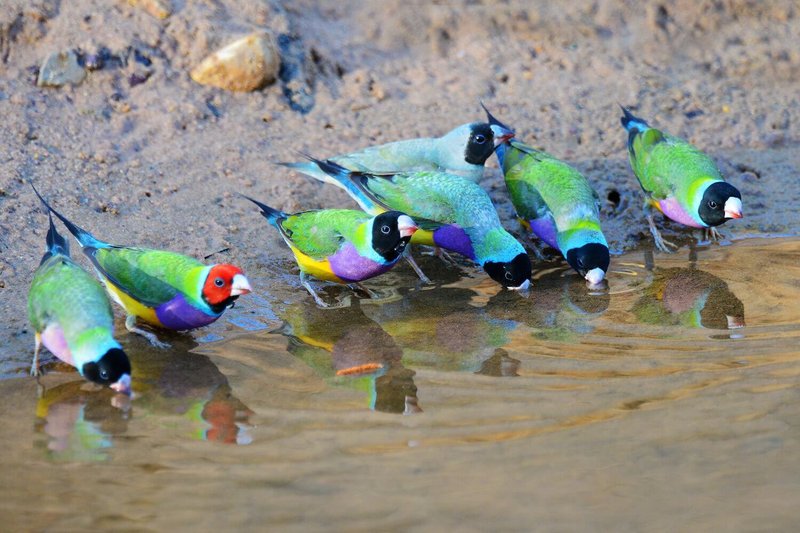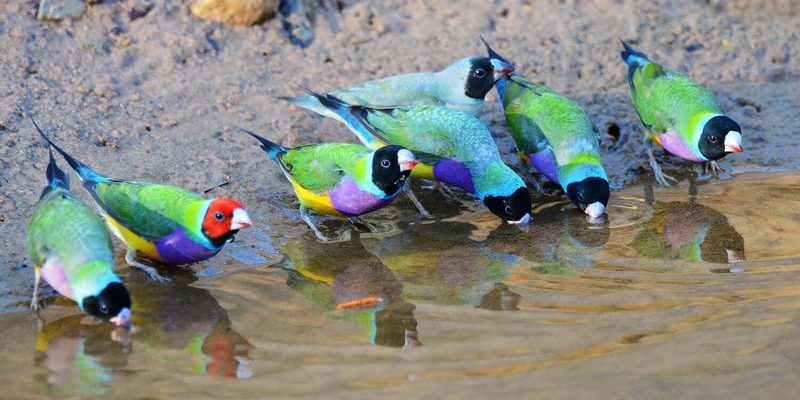
Think of watching a Gouldian Finch like reading a good book. The story unfolds through patterns, colors, and sounds. Just like a seasoned reader can pick out the nuances in a plot, you can learn to pick out the signs that indicate a Gouldian Finch nearby. So, grab your binoculars and let’s dive into the world of these spectacular birds.
Where to Find Gouldian Finches
Identifying a Gouldian Finch starts with knowing where to look for them. These birds are native to Australia and prefer the northern regions, particularly in savanna woodlands and grasslands. They tend to hang out near water sources where they can sip and socialize. So, if you’re planning a birdwatching trip, aim for areas like the Northern Territory or Western Australia.
Here’s what you should keep in mind:
- Habitat: They love open grassy areas with scattered trees. Look for patches of grass where they can forage for seeds.
- Season: Their breeding season runs from October to December, so you’re more likely to spot them during these months.
- Weather: Warm, sunny days are when they’re most active, so try your luck on a pleasant afternoon.
If you’re venturing into their territory, keep an eye out for local birding groups or guides who may know the best spots to find these beauties. You might learn a thing or two and even meet fellow bird enthusiasts!
Color Patterns: The Key to Identification
What sets the Gouldian Finch apart from other birds? Their eye-catching color patterns are a dead giveaway. Adult Gouldian Finches come in a few color variations, but their distinct colors are what you should focus on.
Typically, male Gouldians are more colorful than females. Males often display a bright green back, a yellow belly, and a striking red or black face. Some even sport vibrant purple chests. On the other hand, female Gouldians are usually less flashy, with more muted tones of green and brown.
It’s like being at a costume party: the males are dressed to impress, while the females might opt for a more subtle look.
When trying to identify a Gouldian Finch, pay attention to these patterns:
- Head Color: The males often have a red or black mask that stands out.
- Body Color: Their bodies can show a mix of green, yellow, and blue.
- Size: They’re small, typically about 4.3 to 5.5 inches long.
If you spot a bird that fits this description, chances are you’ve found a Gouldian Finch!
Behavioral Traits to Observe
When you’re trying to identify a Gouldian Finch, behavior can be just as telling as color. These birds are social creatures and often forage in groups. Watching how they interact can give you clues about their species.
Gouldian Finches tend to be lively, flitting from branch to branch. They often enjoy a good splash in the water, and you might catch them taking a quick drink. Here are a few behaviors to look for:
- Foraging: They spend a lot of time pecking at the ground for seeds, often in a lively group.
- Calling: Their chirpy calls are quite distinct. Listen for a mix of soft whistles and trills.
- Socializing: They often group with other finches or birds, creating a lively atmosphere.
Keep your eyes peeled for these behaviors, as they can point you in the right direction for identifying Gouldian Finches.
Recognizing Their Sounds
Ever tried to identify a bird just by its song? It’s a bit like being a detective. The Gouldian Finch has a range of vocalizations that can help you spot them even if you don’t see them right away. Their calls are generally soft and melodic, combining whistles and chirps.
If you hear a series of high-pitched notes, it’s likely a Gouldian Finch. Here are a few sounds to listen for:
- Whistles: Short, sweet tunes that can be heard during foraging.
- Chirps: Quick, repetitive sounds that signify social interaction among flock members.
- Trills: Longer, melodic phrases that are particularly noticeable during mating displays.
Familiarizing yourself with these sounds can enhance your birdwatching experience. You might even find that identifying them becomes a bit easier over time!
Using Binoculars and Spotting Techniques
If you’re serious about birdwatching, investing in a good pair of binoculars is key. For identifying a Gouldian Finch, you want something lightweight and with good zoom capability. A magnification of 8x to 10x is generally ideal.
Here are a few tips for spotting them effectively:
- Stay Quiet: Approach the area slowly, and keep your noise to a minimum. Birds can be skittish.
- Use Natural Cover: Hide behind bushes or trees to get a clearer view without startling the birds.
- Scan from a Distance: Give them space so you can observe their natural behavior without intrusion.
With the right spotting techniques and good binoculars, you’ll increase your chances of seeing these amazing finches up close!
Photography Tips for Capturing Gouldian Finches
So, maybe you’ve spotted a Gouldian Finch, and now you want to capture that moment on camera. Photographing these lively birds can be both rewarding and challenging. Here’s how you can make the most of your bird photography experience.
First off, patience is key. Waiting for the right moment can yield some stunning shots. Consider these tips:
- Use a Telephoto Lens: A lens with a focal length of at least 200mm will help you get those close-up shots without disturbing the birds.
- Natural Light: Early mornings or late afternoons provide beautiful soft light, perfect for capturing vibrant colors.
- Continuous Shooting Mode: Use burst mode to catch those quick movements and interactions among the birds.
With practice, you’ll not only get better at spotting them but also at capturing their beauty through your lens.
Why Identifying Gouldian Finches Matters
Understanding how to identify Gouldian Finches isn’t just for fun—it contributes to conservation efforts too. These birds have seen a decline in their populations due to habitat loss and other environmental pressures. By learning to recognize them, you can help raise awareness about their plight.
When you spot these birds in the wild, it’s an opportunity to contribute to citizen science initiatives. Reporting your sightings helps conservationists track populations and take action where needed. Here’s how you can make a difference:
- Join Birdwatching Groups: Being part of a community can help spread awareness and knowledge about these finches.
- Participate in Surveys: Many organizations run programs where you can report your sightings.
- Support Conservation Efforts: Donating to or volunteering with local conservation groups can amplify your impact.
In a way, every time you identify a Gouldian Finch, you’re playing a part in their survival story.
As you venture out to spot these stunning birds, remember that every observation counts. Whether you’re a beginner or a seasoned birdwatcher, identifying a Gouldian Finch can be a rewarding experience. You’re not just admiring a beautiful creature; you’re connecting with nature and contributing to its future. So, keep your eyes peeled, your ears tuned, and enjoy the magical world of birdwatching!

